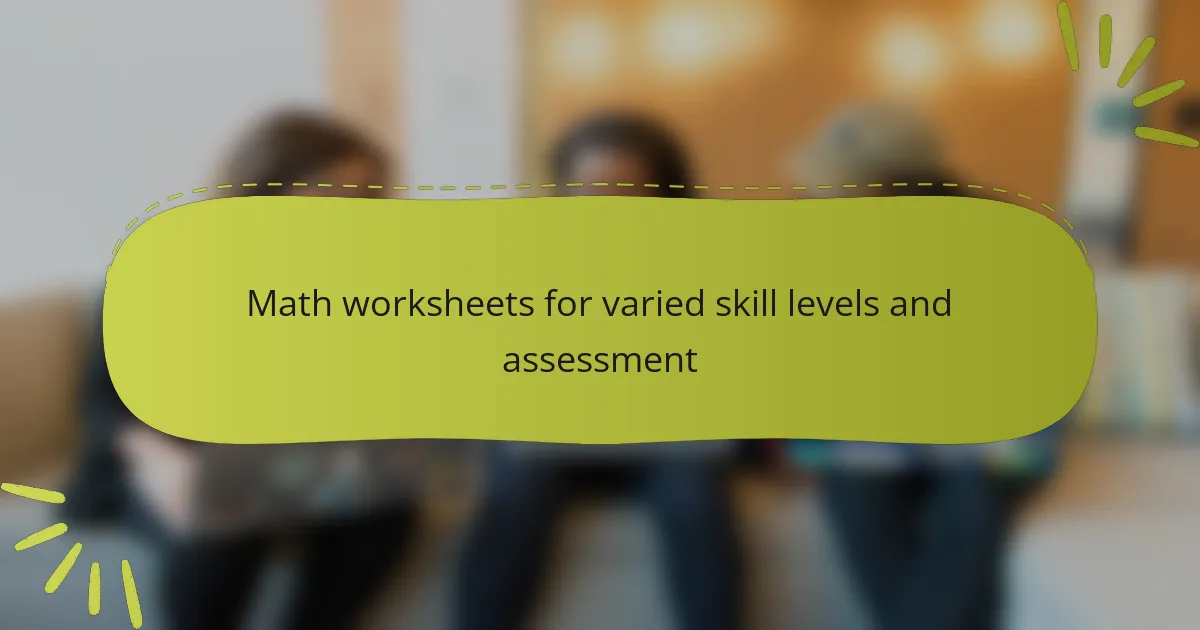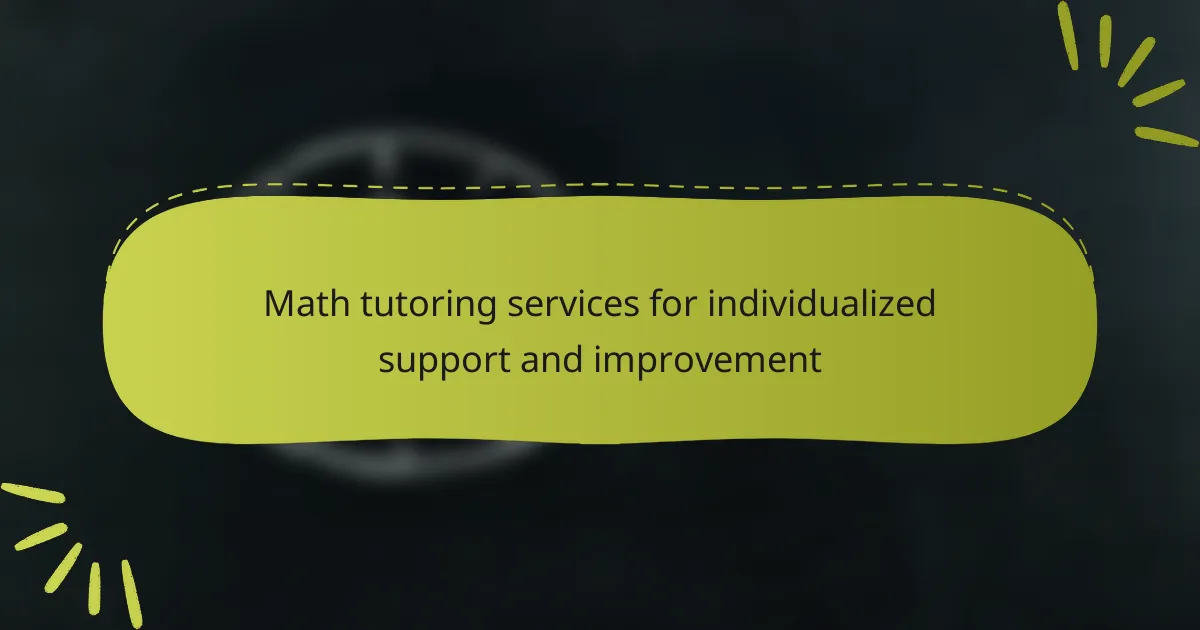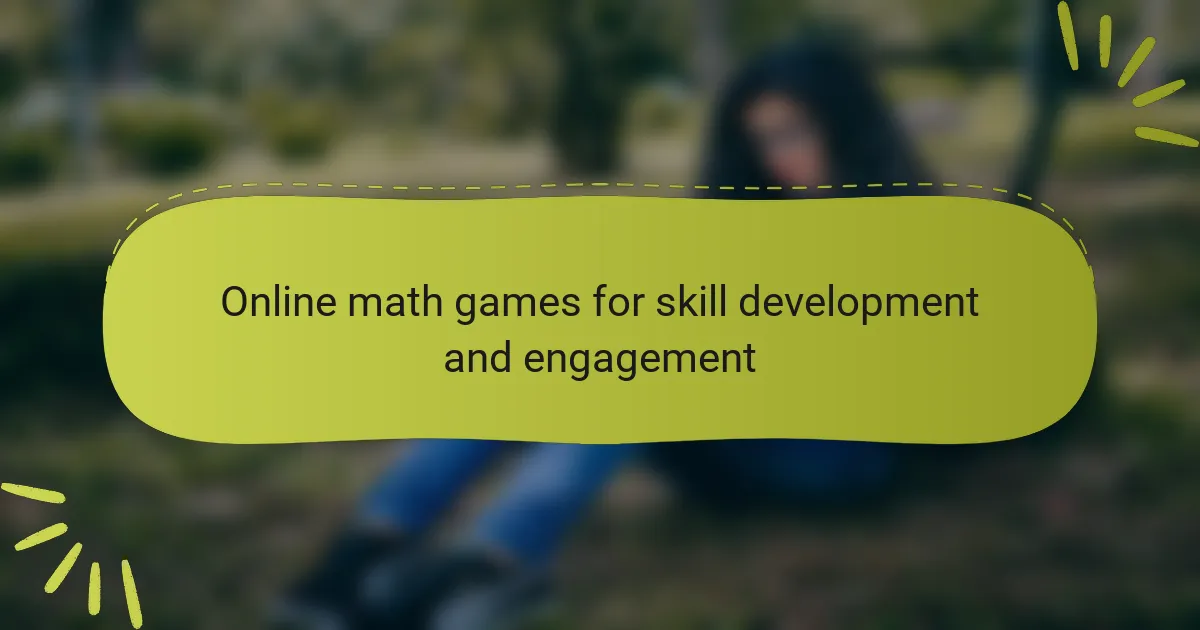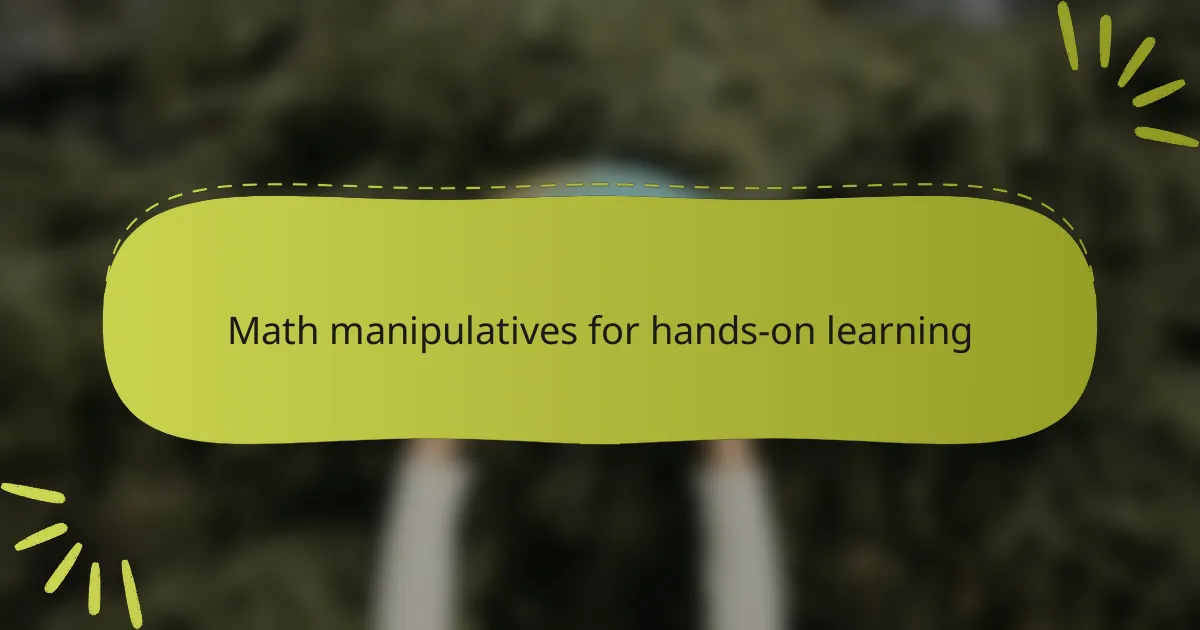Math clubs are organized groups aimed at enhancing mathematical skills and fostering social connections among participants. These clubs facilitate collaborative problem-solving, discussions, and various activities that promote teamwork and communication, leading to improved understanding and retention of mathematical concepts. Effective organization of math clubs involves setting clear goals, establishing a structured meeting schedule, and encouraging member participation through diverse activities. Research indicates that involvement in math clubs not only enhances individual mathematical abilities and confidence but also strengthens community engagement through events and competitions that promote a culture of learning. Overall, math clubs contribute to academic success and create a sense of belonging among members.
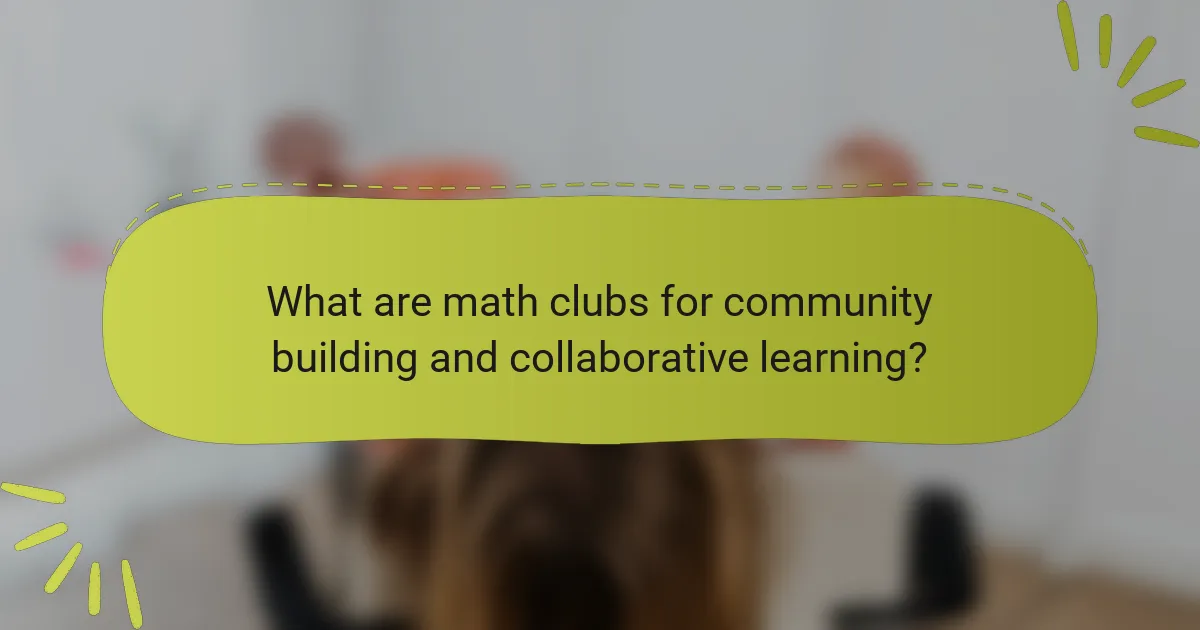
What are math clubs for community building and collaborative learning?
Math clubs for community building and collaborative learning are organized groups focused on enhancing mathematical skills and fostering social connections. These clubs provide a platform for individuals to engage in collaborative problem-solving and share diverse mathematical ideas. Participants often work together on math-related projects, competitions, or discussions, which promotes teamwork and communication. Research indicates that such collaborative environments improve understanding and retention of mathematical concepts. Math clubs can also create a sense of belonging and community among members, enhancing their overall educational experience.
How do math clubs facilitate community engagement?
Math clubs facilitate community engagement by providing a platform for collaboration and interaction among members. They organize events such as workshops, competitions, and social gatherings. These activities encourage participation from diverse community members. Math clubs also promote problem-solving and critical thinking skills. They often partner with local schools and organizations to extend their reach. Research shows that community-based math initiatives improve local educational outcomes. Clubs create a sense of belonging and support among participants. This fosters a positive environment for learning and sharing knowledge.
What activities are typically organized within math clubs?
Math clubs typically organize activities such as problem-solving sessions, math competitions, and guest speaker events. Problem-solving sessions allow members to collaboratively tackle challenging math problems. Math competitions, like Math Olympiads, foster a spirit of teamwork and healthy competition. Guest speaker events invite mathematicians or educators to share insights and experiences. Workshops on specific math topics enhance members’ skills and knowledge. Social events, such as game nights, promote camaraderie among members. Additionally, tutoring programs may be offered to assist peers in understanding math concepts better. These activities collectively contribute to a supportive community focused on collaborative learning in mathematics.
How do these activities promote social interactions?
Math clubs promote social interactions by providing a collaborative environment for participants. Members engage in problem-solving together, fostering teamwork and communication skills. Regular meetings create opportunities for members to share ideas and build relationships. Group activities encourage discussions, enhancing social bonds among participants. Research shows that collaborative learning environments improve interpersonal skills. According to a study by Johnson & Johnson, cooperative learning increases social interaction and improves group dynamics. Math clubs also host events, further connecting members and the community. These activities create a sense of belonging among participants, promoting ongoing social engagement.
Why is collaborative learning important in math clubs?
Collaborative learning is important in math clubs because it enhances problem-solving skills. Members share diverse perspectives, leading to deeper understanding. This interaction fosters critical thinking and encourages peer support. Research shows that students in collaborative settings perform better academically. According to a study by Johnson & Johnson, cooperative learning can increase achievement by 20-30%. Additionally, collaboration builds a sense of community among participants. This social aspect boosts motivation and engagement in math activities. Overall, collaborative learning creates a more enriching and supportive environment for mastering mathematical concepts.
What are the key principles of collaborative learning?
The key principles of collaborative learning include positive interdependence, individual accountability, and face-to-face interaction. Positive interdependence means that group members rely on each other to achieve a common goal. Individual accountability ensures that each member is responsible for their contribution. Face-to-face interaction promotes communication and engagement among participants. Additionally, collaborative learning encourages the development of social skills and group processing. Research by Johnson and Johnson highlights that these principles enhance learning outcomes and foster a supportive learning environment.
How does collaborative learning enhance problem-solving skills?
Collaborative learning enhances problem-solving skills by fostering teamwork and diverse perspectives. In collaborative settings, individuals share ideas and approaches. This exchange leads to innovative solutions that may not emerge in solitary work. Research shows that groups often outperform individuals in problem-solving tasks. A study by Johnson and Johnson (2014) highlights that collaborative learning improves critical thinking and creativity. Participants learn to articulate their reasoning and evaluate others’ ideas. This process builds communication skills essential for effective problem-solving. Overall, collaborative learning creates an environment conducive to deeper understanding and skill development.
What types of math clubs exist for community building?
Math clubs for community building include various types that foster collaboration and learning. These clubs often focus on specific themes, such as problem-solving, recreational math, or competition preparation.
For instance, problem-solving clubs encourage members to tackle challenging math problems together. Recreational math clubs explore puzzles and games that make math engaging. Competition clubs prepare participants for math contests, enhancing teamwork and skills.
Additionally, tutoring clubs provide peer support, helping members understand math concepts better. Online math clubs have emerged, connecting individuals across geographic boundaries.
Each type of club serves to build community by promoting interaction and shared learning experiences among math enthusiasts.
How do school-based math clubs differ from community math clubs?
School-based math clubs primarily focus on students within a specific educational institution. They aim to enhance math skills aligned with school curricula. Community math clubs, on the other hand, are open to all age groups and backgrounds. They foster math learning in a broader social context, often emphasizing collaboration and community engagement.
School-based clubs typically meet during school hours or after school, while community clubs may have more flexible scheduling. School-based clubs often have faculty advisors, whereas community clubs are usually run by volunteers or community organizations.
Research indicates that school-based clubs can lead to improved academic performance in math, while community clubs enhance social skills and community ties. Each type of club serves distinct purposes, catering to different needs within the learning ecosystem.
What online math clubs are available for remote collaboration?
Online math clubs available for remote collaboration include the Art of Problem Solving (AoPS) and Math Olympiad Club. AoPS offers resources for problem-solving and interactive forums for students. The Math Olympiad Club focuses on preparing students for math competitions. Both clubs provide a collaborative environment through online discussions and activities. They encourage engagement through problem sets and peer interactions. Additionally, platforms like Mathigon and Brilliant offer collaborative features for learners. These clubs foster a sense of community among math enthusiasts. They are accessible to students of various skill levels.
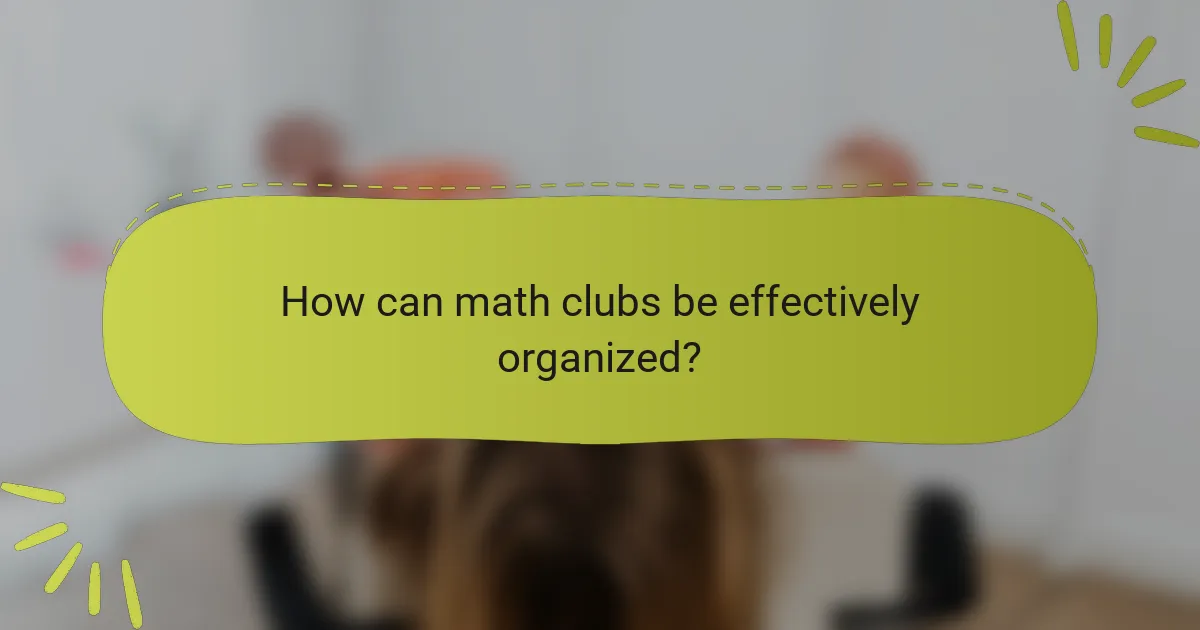
How can math clubs be effectively organized?
Math clubs can be effectively organized by establishing clear goals and objectives. Define the purpose of the club, whether it’s to enhance problem-solving skills or prepare for competitions. Create a structured schedule for meetings, ensuring consistency and commitment. Include a variety of activities, such as collaborative problem-solving sessions and guest speaker events. Encourage member participation by rotating leadership roles and responsibilities. Utilize online platforms for communication and resource sharing. Gather feedback regularly to adapt the club’s activities to members’ interests. Research shows that structured clubs foster a sense of community and enhance learning outcomes.
What are the essential steps in setting up a math club?
Identify interested members to form a core group. Gather individuals who share a passion for math. Establish a clear purpose for the club. Define goals such as enhancing math skills or fostering a love for the subject. Choose a suitable meeting location. Select a space that is accessible and conducive to learning. Set a regular meeting schedule. Consistency helps maintain engagement and participation. Plan activities and resources. Include games, competitions, and collaborative projects to keep members motivated. Promote the club within the community. Use flyers, social media, and word of mouth to attract more members. Establish a leadership structure. Assign roles such as president, treasurer, and secretary for better organization. Evaluate and adjust the club’s activities regularly. Gather feedback to ensure the club meets the needs of its members.
How can leaders recruit members for the club?
Leaders can recruit members for the club by promoting the benefits of participation. They should highlight how math clubs foster collaborative learning and community engagement. Utilizing social media platforms can effectively reach potential members. Hosting introductory events can showcase the club’s activities and values. Personal invitations can create a welcoming atmosphere for new members. Collaborating with local schools can increase visibility and attract students. Providing clear information about meeting times and activities can help interested individuals join. Engaging current members in recruitment efforts can create a sense of ownership and enthusiasm.
What resources are needed to run a successful math club?
To run a successful math club, essential resources include dedicated space, materials, and skilled leadership. A dedicated space provides a location for meetings and activities. This space should be accessible to all members. Materials such as textbooks, worksheets, and manipulatives support learning and engagement. These resources enhance understanding of mathematical concepts. Skilled leadership is crucial for guiding discussions and activities. Effective leaders motivate members and facilitate collaboration. Additionally, access to technology, such as computers or calculators, can enhance learning experiences. Community connections, like partnerships with local schools or organizations, can also provide support and resources.
How can math clubs foster inclusivity and diversity?
Math clubs can foster inclusivity and diversity by creating welcoming environments for all participants. They can implement outreach programs to engage underrepresented groups. This includes targeting schools with diverse student populations. Math clubs can also offer mentorship programs pairing experienced members with newcomers. Workshops focusing on culturally relevant math topics can further enhance engagement. Providing resources in multiple languages ensures accessibility for non-native speakers. Additionally, creating a safe space for sharing experiences promotes open dialogue. Research shows that diverse groups enhance problem-solving and creativity, benefiting all members.
What strategies can be implemented to welcome all participants?
To welcome all participants in math clubs, inclusive strategies should be implemented. First, create a welcoming environment by using clear and accessible language. This reduces barriers for participants with varying math backgrounds. Second, provide orientation sessions for new members. These sessions help familiarize everyone with club activities and expectations. Third, encourage diverse participation by promoting events in various community channels. This outreach can attract different demographics. Fourth, implement icebreaker activities at the start of meetings. Icebreakers foster connections among participants and build a sense of belonging. Lastly, solicit feedback regularly from members. This practice ensures that everyone’s voice is heard and valued, leading to continuous improvement in the club’s inclusivity.
How can math clubs address varying skill levels among members?
Math clubs can address varying skill levels among members by implementing differentiated instruction. This approach tailors learning experiences to meet individual needs. Clubs can organize activities that cater to different skill levels. For example, they can create beginner, intermediate, and advanced groups. Each group would work on tasks suited to their abilities. This fosters an inclusive environment where all members can participate. Additionally, peer mentoring can be encouraged. More skilled members can support those who are less experienced. Research shows that collaborative learning enhances understanding and retention of concepts. Thus, math clubs can effectively support diverse skill levels through these strategies.
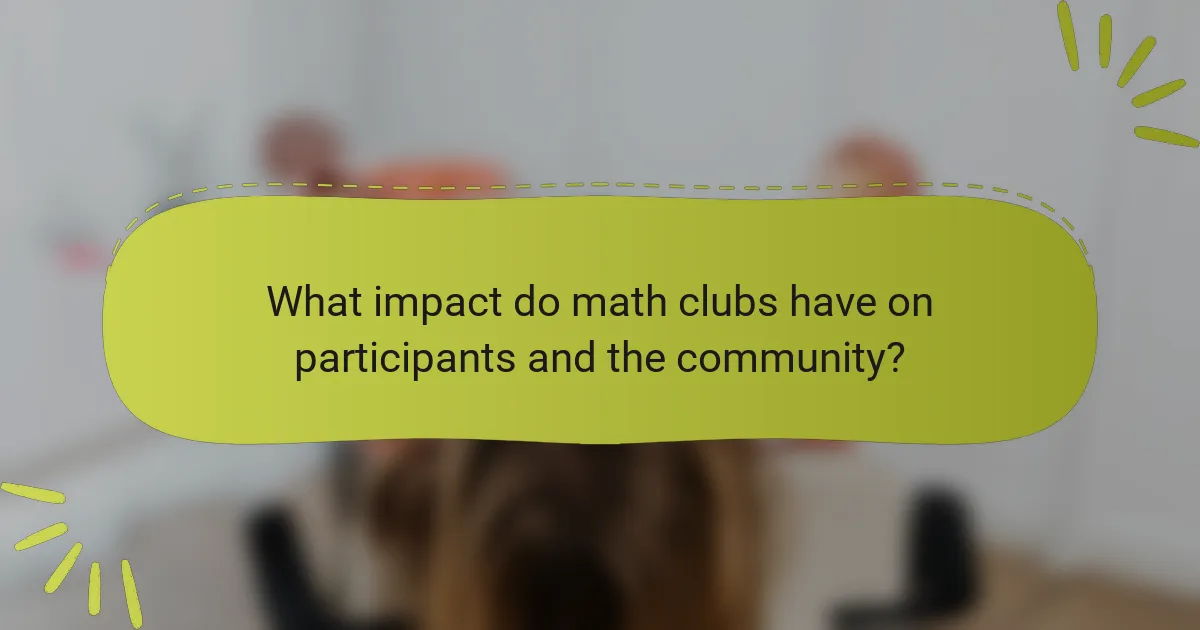
What impact do math clubs have on participants and the community?
Math clubs positively impact participants and the community by enhancing mathematical skills and fostering social connections. Participants often experience improved problem-solving abilities and increased confidence in their math skills. These clubs provide a supportive environment for collaborative learning. They encourage teamwork and communication among members.
Community engagement is also a significant benefit. Math clubs often host events and competitions that involve local schools and families. This outreach promotes a culture of learning and curiosity about mathematics in the broader community.
Research shows that students involved in math clubs perform better academically. A study by the National Council of Teachers of Mathematics found that extracurricular math activities improve student achievement. Overall, math clubs create a sense of belonging and community involvement while advancing mathematical understanding.
How do math clubs improve participants’ mathematical skills?
Math clubs improve participants’ mathematical skills through collaborative problem-solving and peer support. Participants engage in discussions that deepen their understanding of mathematical concepts. They tackle challenging problems that enhance critical thinking. Regular practice in a supportive environment builds confidence in their abilities. Exposure to diverse problem-solving strategies broadens their mathematical toolkit. Research shows that students in collaborative settings perform better in mathematics assessments. A study by the National Council of Teachers of Mathematics indicates that group learning leads to higher achievement levels. These factors collectively contribute to improved mathematical skills among math club participants.
What evidence supports the effectiveness of math clubs in learning?
Math clubs enhance learning through collaborative problem-solving and peer interaction. Research indicates that students in math clubs show improved mathematical reasoning and problem-solving skills. A study published in the Journal of Educational Psychology found that participants in math clubs scored higher on standardized tests compared to non-participants. Additionally, a report by the National Council of Teachers of Mathematics highlights increased student engagement and motivation within math clubs. These environments foster a sense of community, which further supports learning outcomes.
How do math clubs influence participants’ confidence in math?
Math clubs significantly enhance participants’ confidence in math. They provide a supportive environment where individuals can explore mathematical concepts without the pressure of grades. Regular participation fosters a sense of belonging among members. This community aspect encourages sharing of ideas and collaborative problem-solving. Engaging in group activities allows participants to see diverse approaches to math. As members tackle challenges together, they build resilience and improve their skills. Research shows that students involved in math clubs report higher self-efficacy in their mathematical abilities. The National Council of Teachers of Mathematics supports this, highlighting positive impacts on student confidence through collaborative learning experiences.
What role do math clubs play in building community connections?
Math clubs play a significant role in building community connections. They provide a space for individuals to collaborate and engage in mathematical discussions. Members often share diverse perspectives and problem-solving strategies. This interaction fosters relationships among participants. Additionally, math clubs often organize events that involve the broader community. These events can include math competitions, workshops, and tutoring sessions. Such activities promote inclusivity and encourage community participation. Research shows that community-based educational initiatives enhance social cohesion. Math clubs exemplify this by connecting individuals through a shared interest in mathematics.
How can math clubs collaborate with local organizations?
Math clubs can collaborate with local organizations by organizing joint events and workshops. These events can focus on math education and community engagement. For example, math clubs can partner with local schools to host math competitions. They can also work with libraries to provide tutoring sessions for students. Collaborations can include hosting community math nights to promote interest in mathematics. Additionally, math clubs can engage with local businesses for sponsorships or resources. Such partnerships can enhance learning experiences and create a stronger community connection. Collaborative efforts can also lead to shared resources, benefiting both the math clubs and local organizations.
What community events can math clubs participate in or host?
Math clubs can participate in or host various community events. They can organize math competitions to engage students in problem-solving. Workshops can be held to teach specific math skills or concepts. Math fairs provide an opportunity to showcase projects and activities. Community service events can include tutoring sessions for local schools. Math clubs can also host family math nights to involve parents and children together. Collaborating with local libraries for math-themed events is another option. Additionally, math clubs can participate in STEM festivals to promote interest in mathematics. These activities foster collaboration and enhance community engagement in learning.
What are some best practices for running a successful math club?
Establish clear goals for the math club. Goals help members understand the club’s purpose. Create a structured meeting schedule. Regular meetings foster consistency and commitment. Encourage collaboration among members. Group activities enhance problem-solving skills. Incorporate diverse math topics. A variety of subjects keeps interest high. Invite guest speakers occasionally. Experts provide new insights and inspiration. Use competitions to motivate members. Math contests can enhance engagement and teamwork. Provide resources for self-study. Access to materials supports independent learning. Gather feedback regularly from members. Feedback helps improve the club’s activities and direction.
How can leaders maintain engagement and motivation among members?
Leaders can maintain engagement and motivation among members by fostering a collaborative environment. They should encourage open communication and provide opportunities for members to share ideas. Setting clear goals can help members understand their contributions. Regular feedback is essential for recognizing achievements and areas for improvement. Additionally, incorporating fun and interactive activities can enhance participation. Research indicates that active involvement leads to higher motivation levels. A study by Deci and Ryan (2000) highlights the importance of autonomy and competence in motivation. Therefore, leaders should empower members to take ownership of tasks.
What common challenges do math clubs face and how can they be overcome?
Math clubs commonly face challenges such as low participation, lack of resources, and varying skill levels among members. Low participation can be addressed by promoting the club through school events and social media. Lack of resources can be overcome by seeking partnerships with local businesses or educational institutions for funding and materials. Varying skill levels can be managed by creating subgroups that cater to different abilities, allowing tailored learning experiences. Engaging activities and competitions can also motivate members to participate consistently. These strategies help to foster a more inclusive and active math club environment.
Math clubs for community building and collaborative learning are organized groups aimed at enhancing mathematical skills and fostering social connections among participants. These clubs facilitate community engagement through collaborative problem-solving, workshops, and competitions, promoting teamwork and critical thinking. Activities within math clubs typically include problem-solving sessions, guest speaker events, and tutoring programs, which collectively contribute to a supportive learning environment. Additionally, math clubs play a significant role in building community connections by hosting events that involve local schools and families, ultimately improving educational outcomes and enhancing participants’ confidence in their mathematical abilities.
